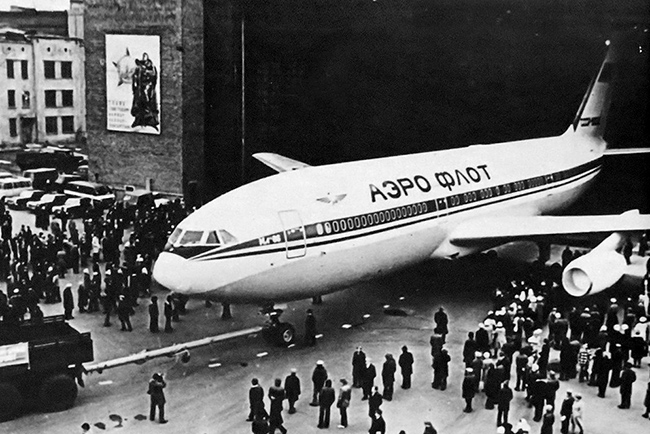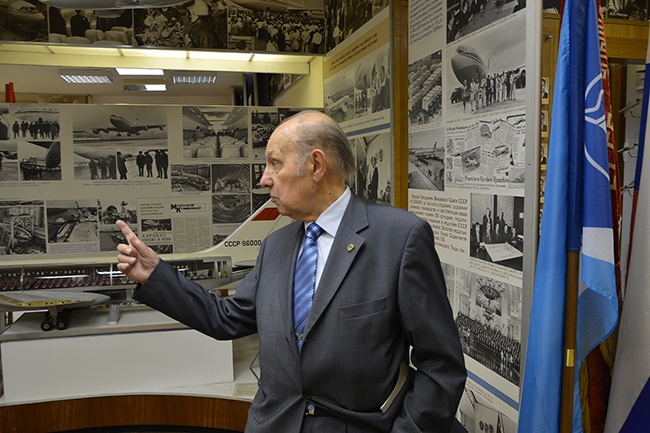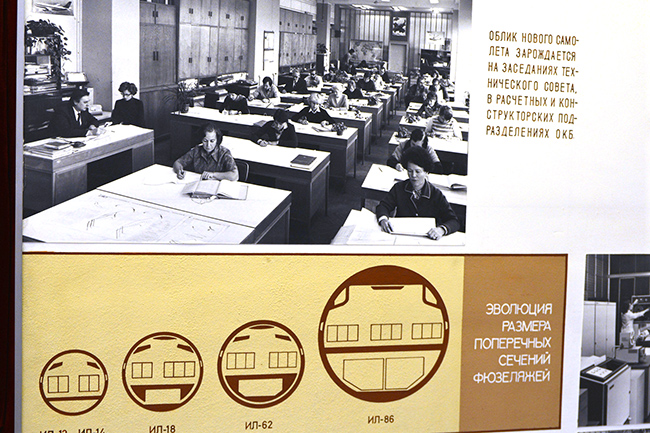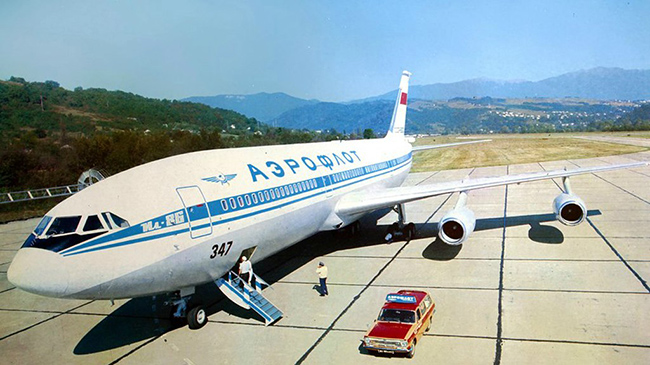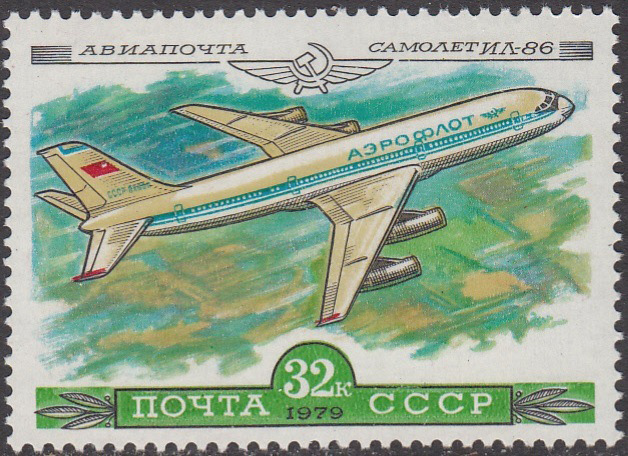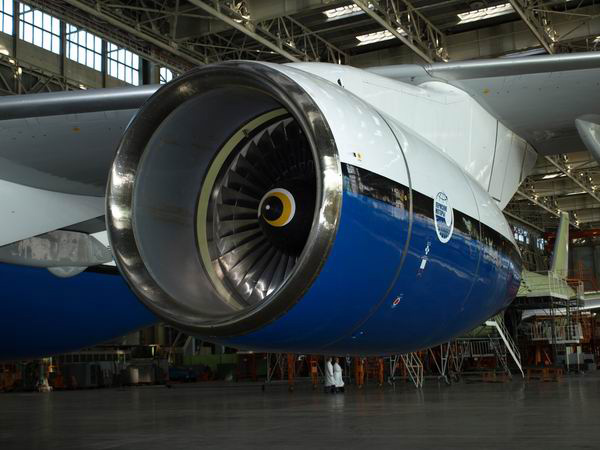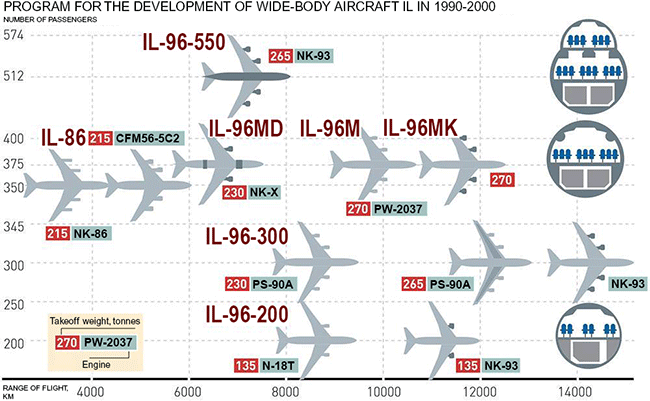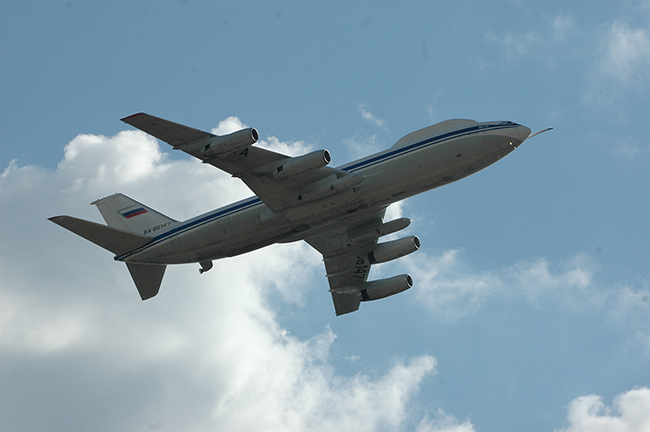In the fall of 1977 Voronezh aircraft builders rolled out of the assembly hangar and made the maiden flaght of the first serial IL-86, which soon entered operational testings at Aeroflot and later was used to transport passengers on a central timetable. This aircraft was the fourth, the next after three prototypes, built in Moscow at the plant Special Design Bureau named after Sergei Vladimirovich ILyushin. A total of one hundred and three IL-86s were assembled in Voronezh, after what they switched to the release of its successor - IL-96.
Following the leader
In the Soviet Union, they began the research on a passenger aircraft of extra-large capacity in 1969. The motivation was the emerge in the United States of the so-called wide-body jetliners, the first of which was Boeing 747, which entered into the service in 1970. Following the leader, a couple of American firms brought to the market similar products. McDonnell Douglas offered the airlines DC-10 (in operation since 1971), and Lockheed - L-1011 TriStar (1972). From previously created jet passenger aircraft, they were distinguished by a fuselage of increased diameter, in the cross section of which the seats were divided into two passages, with the placement of seven passengers or more in each row.
The creation of such air giants was a matter of science, intensive and very costly, which explains the delay of several years with similar developments in the USSR and Western Europe. To be noted, the aircraft construction companies were looking for their own way, trying to choose the most optimal configuration, in terms of their engineers and marketers. So, the Boeing 747 was a two-deck four-engine, and DC-10 and L-1011 - with one deck and three engines. And European companies that joined as the Airbus, began with the delivery of twin-engine A300 in 1974, but it was interfering to the Americans’ in dimension.
As a passenger aircraft of extra-large capacity, Sergei Vladimirovich ILyushin proposed an option of an elongated 6.8 meter IL-62M, so that the capacity was increased to 250 seats. However, they decided to abandon this idea in favour of a completely new machine with a wide fuselage, allowing the placement of blocks of passenger seats separated by two aisles. Its development was conducted under the leadership of Henry Vasilyevich Novozhilov, who took over as General Designer in the summer of 1970.
Great attention was paid to the theme of choosing the diameter of the fuselage. After analysing, it was settled on a version of 6.08 meters, which allowed to accommodate in the cross section three "benches" with three seats in each. American DC-10 and L-1011 also had a characteristic parameter in the area of six meters and the layout of the cabin of nine seats in a row, though in a slightly different configuration - with a central "block" of four seats.
The chosen layout added another "bench" to two in aircraft with the so-called "standard fuselage", also known in the international civil aviation community as "narrow-body aircraft". Then the number of those included domestic IL-62 and Tu-154.
Design, construction and testing
The studies carried out together with the specialists of the Central Aerohydrodynamic Institute (CAHDI) led to the choice of the low-plan scheme of the normal scheme with a wing sweep of a quarter-chord 35 degrees and four engines on wing pylons. This arrangement promised a high aerodynamic quality when performing normalised characteristics of stability and controllability. The decrease in the landing distance was planned to be obtained due to the developed mechanisation of the wing, including the slats and the three-slit flaps.
Due to advanced automation systems, the Airbus crew was reduced to three people, which was a great achievement of that time, taking into account the backwardness of domestic civilian avionics. The weak material and technical base, the condition of the runways and terminals of many Soviet airports of those years left much to be desired. Therefore, when designing the aircraft, they decided to follow the principle of "luggage with you plus containers" and equip the aircraft with three entrance doors with built-in gangways so that the landing and disembarkation of passengers could take place without the use of airfield facilities.
The design and construction of an experimental aircraft took six years - a very short time for such a large airliner. Visiting the plant in November 1976, board 0101 was inspected by the Minister of Aviation Industry Pyotr Dementyev. «Great! We have built it!» - he said.
The first prototype of IL-86 took off on December 22, 1976 from the Central Airfield named after MV Lomonosov. Frunze in the center of Moscow, and landed on the site of the Flight Research Institute in the Moscow region of Zhukovsky. The aircraft was piloted by a crew led by Hero of the Soviet Union, Honored Test Pilot Eduard Ivanovich Kuznetsov, who also included G.N. Volokhov, I.N. Yakimets, V.A. Shchetkin and AP. Stepanov. Minister of Civil Aviation Boris Pavlovich Bugayev arrived for the first flight of IL-86.
The creation of the IL-86 was considered a great achievement for domestic aircraft builders, and the Kremlin allowed them to demonstrate the aircraft at the 32nd aerospace show in Le Bourget, Paris. The foreign press reviews were enthusiastic. Journalists compared the "Soviet Airbus" with the wide-bodied first-born of Western Europe. With a take-off weight of 142 tons, the A300B2 carried 250 passengers for a distance of 3,700 km, and the IL-86 carried 350 passengers at 4350 km with its 215 tons. Dimensions of the cabin: length 39 meters against 44, width - 5,35 against 5,7, height - 2,54 against 2,61. In many respects, "IL" was ahead, yielding only on the specific fuel consumption per passenger.
Let us note that the international debut of the "Soviet Airbus" took place fifteen months before the completion of the factory tests on September 22, 1978. They were conducted on two prototypes, which were intended to confirm the flight performance, and the third, built to test the flight-navigation complex. Then the IL-86 entered the State Tests. A total of 1414 flights with a total duration of over two thousand hours were carried out. Static and resource tests were conducted on two specially designed gliders. The certificate of type for compliance with the airworthiness standards of AWS-2 was issued on December 24, 1980. Thus, exactly ten years passed from the beginning of the design to the arrival of the aircraft in operation.
Commercial Operation
Serial production of the aircraft was assigned to a well-equipped plant in Voronezh, where supersonic Tu-144s were previously built. The first aircraft that was assembled here flew on October 24, 1977, the flight lasted thirty minutes. Operational tests in Aeroflot included 490 flights with a total duration of 1,222 hours.
Regular flights with passengers on board opened on December 26, 1980 by Moscow-Tashkent flight, and the next summer they went to the international routes. The number of foreign countries, which flew the IL-86, in 1987 reached fifteen. "Soviet Airbuses" were sent to dozens of airports in Europe, as well as Damascus, Amman, Djibouti in the Arab East. The final points of routes in Southeast Asia included Beijing, Pyongyang, Hanoi, Bangkok, Singapore, Delhi, Calcutta and Karachi. Transatlantic flights were also carried out, including to Montreal, New York (with an intermediate landing in Shannon, Ireland) and Havana (via Gander on the island of Newfoundland).
Inside the country, in 1983-1987. IL-86 served the cities of Moscow, Leningrad, Kiev, Simferopol, Sverdlovsk, Kavminvody, Sochi, Sukhumi, Norilsk, Aktyubinsk, Kemerovo, Krasnoyarsk, Novosibirsk, Khabarovsk, Yerevan, Tashkent and Almaty.
The growth of the fleet of "Soviet Airbuses" is swift: from 1983 to 1986, it increased from 20 thousand to 55,249 hours. And by July 1, 1987 the number of passengers transported by "Soviet Airbuses" reached 24 million 320 thousand people. The average load on Aeroflot flights was 70%, the regularity of flights according to the schedule is 96-98%. Good indicators, even by today's standards with reference to "foreign aircraft".
After the collapse of the "One and Mighty" Soviet Aeroflot, the IL-86 were at the disposal of eleven Russian airlines and several national carriers of the CIS countries. In addition, China has purchased three cars, where they have been successfully operated since 1990 on the China Xinjiang Airlines network of routes from Urumqi Airport, the capital of the Xinjiang Uygur Autonomous Region. Subsequently, the IL-86 was replaced by American and European "jets", but local aviators and passengers for a long time with love recalled the "Soviet Airbus" as perfectly adapted to work in local conditions. Unlike the "Western analogues," the IL-86 was equipped with pull-out ladders, and allowed passengers to board and disembark without resorting to airfield equipment.
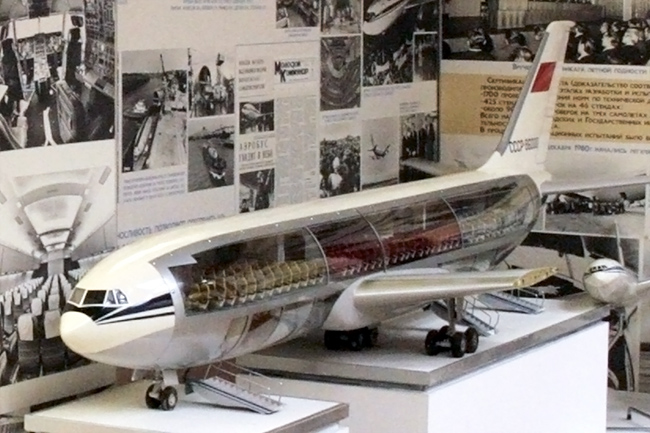
The post-Soviet period of the functioning of the domestic air transport system was characterised by a sharp reduction in traffic volumes. There were difficulties with ensuring a high loading of wide-bodied airliners. However, those airlines that sold a sufficient number of tickets flew without interruption. For a long time, the IL-86 remained in demand for flights on the central timetable between the capital of Russia and Krasnoyarsk, Novosibirsk and Tashkent. A good economy was observed in tourist destinations, resorts on the coast of the Persian Gulf, Black and Mediterranean seas, where loading seats sometimes reached 100%. At the turn of the century, the share of IL-86 in the charter flights of Russian airlines was about 40%.
Commercial exploitation of the IL-86 lasted from 1980 to 2011. The aircraft proved to be extremely reliable. Suffice it to say that for thirty years of work in airlines "Soviet Airbus" did not kill a single passenger - a few accidents on this type happened only on the ground and when performing technical flights. Flight safety indicators for this type were higher than those of Boeing and Airbus, which even the apologists of Western aircraft had to admit.
Power unit problem
A significant contribution to ensuring high safety performance was made by NK-86 engines, developed by the Samara Scientific and Technical Complex named after N.D. Kuznetsov. To make sure of their reliability and "inability" at an early stage of the trials helped the case. A powerful air stream into the air intake was sucked by the winter fur hat of one of the technicians that was preparing the aircraft for takeoff. The subsequent inspection did not detect any traces of the cap or damage to the motor.
Most of all, the airlines liked the option NK-86A with thrust on the takeoff mode, increased to 13.3 tons. It featured mono-crystalline blades of the first stage of the turbine, and an overhaul life of 4000 hours. Similar engines were produced by the Kazan Machine-Building Production Association, beginning in 1987.
But the reverse side of reliability was high fuel consumption. NK-86 was a modification of NK-8, tested by time on the aircraft of the previous generation Tu-154B and IL-62. While foreign aircraft manufacturers switched to highly economical engines with a two-contour ratio of 4-8 units, the corresponding figure for NK-86 was only 1.18. As a consequence, the specific fuel consumption for the cruising mode was 0.739 kg / kgf * h versus 0.536 for the American PW4056 (the degree of the double circuit was 4.9), which was installed on Boeing 767 and 747 variants.
The decision to equip the IL-86 with a morally obsolete power plant was forced. Designers OKB them. S.V. ILyushin had to rely on the modification of NK-8 after the talks with the English company Rolls-Royce on engines of the Rb.211 family fell through. Various modifications of them were supposed to be ordered to complete the serial "IL" and "AN".
Firms agreed to sell the favoured engines, but they requested a minimum lot of one hundred sets for a total of a quarter of a billion dollars. The Soviet negotiators considered the conditions unacceptable, having decided that it is better to send such large funds to the development of their own motor-building. In the end, Rb.211 did get on domestic airliners, but it happened much later, and not for IL and An aircraft, and Tu-204-120 for the Egyptian investor.
Domestic motor-builders were asked to follow the path of a universal gas generator, on the basis of which it would be possible to develop variants of engines for the An-124 Ruslan and IL-86, which differ in the configuration of the cold part. The subsequent analysis showed that such a solution is fraught with the release of non-optimal motors. Priority was given to the military transport aircraft, for which a highly economical D-18T thrust of 24 tons was created. However, the development took a long time; experienced "Ruslan" went on a flight on December 24, 1982 - six years after the start of operation of the IL-86.
Ремоторизация
At the turn of the century, an idea arose to re-equip the "Soviet Airbuses" in operation for the CFM56-5C-2 engines, developing a joint venture of the American company General Electric and the French Snecma. They proved to be the most suitable for replacement of NK-86 in traction and dimensions. Due to the reduced fuel consumption of the power plant, the range of the remotorized liner with 350 passengers on board increased from 4,350 to 6,400 km.
Unfortunately, the domestic aviation industry and its curators in the then government of the Russian Federation did not show proper perseverance in the interactions with the airlines. They failed to form a "pool" of commercial operators willing to "dump" the project. Meanwhile, in conversations with journalists, senior Aeroflot executives, such as the then deputy general director Nikolai Glushkov, argued that they support the idea of updating the IL-86 fleet. But provided that the industry will give clear answers to the questions, in what time period and for what means can it be converted not by an experienced aircraft, but by dozens of production vehicles? The answers offered did not satisfy the airline.
According Glushkov, modernisation should be conducted in the entire fleet of IL-86, and in addition to the power plant, also update the interior and avionics, that is, to approach the topic in a comprehensive manner. Since it was a question of the temporary withdrawal of aircraft from service, the idle period would be better used to perform various types of work, which together would give the maximum effect on improving the aircraft. No matter how it was, the lack of targeted funding ruined, in general, a sound idea for remotorization.
Long-haul variant
The theme of the intercontinental wide-body aircraft with a capacity of 300-350 seats was first discussed between Novozhilov, Dementiev and Bugaev in October 1972. The variants presented by the design bureau, in fact, represented the development of the IL-86 with the replacement of the power plant with more economical engines. Samara motor-builders offered NK-56 with a thrust of 18 tons and a degree of two-contouriness of about five, received for testing in 1980, and then - an even more advanced NK-64 with a cruising expense of 0.54 kg / kgf * h (against 0.739 in NK-86 ). However, in the end, it was decided to focus on the Perm PS-90 as a universal for the four-engine "IL" and twin-engine Tu-204.
The IL-86D (long-haul) project laid the foundation for the creation of the much more advanced IL-96-300 with a new wing of increased size (an increase of ten meters, with 48 for IL-86) and an area of 350 square meters (against 320) with a reduced five degrees sweep angle. The length of the aircraft was 55 meters by shortening the cylindrical part of the fuselage by five and a half meters. The capacity was reduced from 300-350 passengers to 235-262 depending on the configuration of the cabin. The maximum takeoff weight increased from 215 to 230, and later - 250 tons. The first IL-96-300 flight was made on September 28, 1988 and received the airworthiness certificate on December 29, 1992.
The next step in the development of wide-body airliners of the brand was the IL-96M / T with American engines Pratt & Whitney PW-2337 (17400kg thrust, specific consumption at cruising speed 0.563 kg / kgf * h, the degree of two-circuit 6), and then its fully Russian version IL- 96-400M with PS-90A1. The length of the aircraft increased by a cylindrical insert 10.5 meters (5 meters to IL-86), the maximum take-off mass increased to 270-275 tons, the wing area - up to 391.6 square meters.
Prospective plans based on the IL-86 and its development of the IL-96 were intended to create a broad family of unified aircraft, the type of Airbus and Boeing. To include it like an extra-spacious IL-96-550 with a number of seats about half a thousand, and a twin-engine IL-98 in the complete set with engines PW-4082 or NK-92/93.
Conclusion
Concluding the story about the IL-86, we emphasise that the creation of the first domestic airliner with a wide fuselage allowed the Soviet aviation industry to take another step forward in its development, and Aeroflot to significantly increase the volumes and safety of air transportation. On the basis of this machine, with preservation of sections of the fuselage, the long-haul IL-96-300 and its long version IL-96-400M were developed.
In just twenty years of production (a pair of extreme machines left the assembly shop in 1995 and 1997), the Voronezh Aviation Plant produced one hundred and three IL-86s, including the special version of the IL-86VKP ("air command post", also known as IL-80).
Taking into account the experienced machines and development in the person of IL-96, the total number of built aircraft of the family reaches 136. According to the plans of the UAC and the Russian government, the production of wide-body "IL" in Voronezh will continue with the release of the improved version of IL-96-400M first with PS-90A1, and then - the Perm engine of the next generation PD-14.
The commercial operation of the basic IL-86 was completed six years ago, but its special variations continue to operate in state aircraft. As far as we know, several "air command posts" are in service and in storage. It turns out that forty years after the first serial IL-86 of Voronezh built, some copies of this outstanding airliner "Soviet Airbus" continues to serve the country by faith and truth.





